History
The Ceylon Army General Service Corps was raised on 14 December 1951 with Lt. Col B.J Wijemanne, MBE, ED as first Commanding Officer. The unit was then administered by the headquarters company of the Army HQ. The Pay and Records Wing which was established on 14 October 1949 and the Education Branch were amalgamated in 1954. The Army Education Branch was instrumental in translating army forms, preparation of a comprehensive Sinhala vocabulary and teaching Sinhala to those who were yet conversant in the language.
The Army Band was formed on 22 June 1950 with Lt (Quarter Master) George Perry, a seconded officer form the British Army and 28 local bandsmen. In 1955 the then Acting Commander of the Army Col. H.W.G Wijekoon, OBE, ED, CLI (later Major General) initiated the forming of the Hewisi Band along with Lt C.T Caldera, CLI and Mr Lional Edirisinghe who was one of Sri Lanka's foremost musicians. S/Sgt Wickramasinghe D. was the first Bandmaster. The cultural troupe of the National Service Regiment (NSR) under Captain Clarence Delwela was absorbed into the SLAGSC when the NSR was disbanded in 1977. Today, the regiment has three bands which take part in all military ceremonials in the country and a cultural troupe.
In 1956 a small farm was established at Panagoda which was the beginning of the farm projects in the Army. Maj. R Wijesinghe (later Colonel) was the pioneer agriculturist and the main figure behind the successful farm projects in the Army. Since then the army farms are also a part of the corps responsibility and they provide most of their produce to the Service Corps.
The Ceylon Defence Force (CDF) was established in 1910 by the Ceylonese legislation Ceylon Defence Force Ordinance, which reformed the Ceylon Volunteer Force (CVF) that existed previously as the military reserve in the British Crown colony of Ceylon. At the time of forming it was only a reserve force but soon developed into a regular force responsible for the defence of Ceylon. The CDF was under the command of the General Officer Commanding, Ceylon of the British Army in Ceylon if mobilised. However mobilisation could be carried out only under orders from the Governor.

Lieutenant General Denzil Lakshman Kobbekaduwa, RWP, RSP, VSV, USP was a senior Sri Lankan Army officer who served in the 1971 Insurrection and the Sri Lankan Civil War.
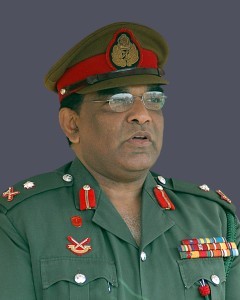
Lieutenant General Parami Sugandika Bandara Kulatunga, RSP, VSV, USP was a senior Sri Lanka Army officer. He was serving as the Deputy Chief of Staff of the Sri Lanka Army and its third highest-ranking officer at the time of his assassination. On the morning of 26 June, he was killed by a Tamil Tiger suicide bomber who drove an explosives laden motorbike into his staff car as it was driving to a military base at Pannipitiya near Colombo.

The Sri Lanka Army is the oldest and largest of the Sri Lanka Armed Forces. Established as the Ceylon Army in 1949, it was renamed when Sri Lanka became a republic in 1972. In 2010, the Army had approximately 200,000 regular personnel, between 20,000 and 40,000 reserve (volunteer) personnel and 18,000 National Guardsmen and comprises 13 divisions, one air-mobile brigade, one commando brigade, one special forces brigade, one independent armored brigade, three mechanized infantry brigades and over 40 infantry brigades. From the 1980s to 2009, the army was engaged in the Sri Lankan Civil War.
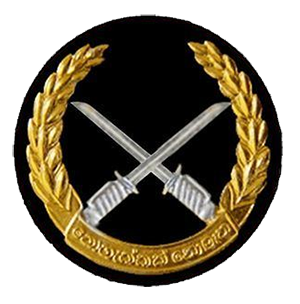
The Commando Regiment is the commando formation of the Sri Lanka Army. The unit specializes in various roles including hostage rescue, counter-terrorism, unconventional warfare, special reconnaissance, counter-insurgency, and personnel recovery. It was formed in 1980 and is based in Ganemulla, a suburb of Colombo.

The Sri Lanka Artillery (SLA) is the artillery arm of the Sri Lanka Army. It is made up of ten regular regiments and two volunteer regiments. The SLA is headquartered at Panagoda Cantonment, Panagoda.
The Sri Lanka Engineers (SLE) is a combat support arm of the Sri Lanka Army which provides military engineering. It is made up of ten regular regiments and one volunteer regiment. Headquartered at Panagoda Cantonment, it is headed by the Centre Commandant.

The Sri Lanka Signals Corps (SLSC) is a combat support corps of the Sri Lanka Army, responsible for providing military communications, information technology and electronic warfare support. The corps is made up of a signals brigade, ten regular regiments and one volunteer regiment. It is responsible for installing, maintaining and operating all types of telecommunications equipment and information systems. It is headquartered at the Panagoda Cantonment.
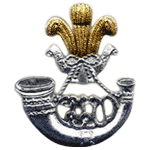
The Sri Lanka Light Infantry (SLLI) is the oldest regiment in the Sri Lanka Army and the oldest infantry regiment in the army. It is made up of ten regular battalions and five volunteer battalions, and is headquartered at the Panagoda Cantonment, Panagoda. Over the years it has become the most distinguished and dependable regiment in the army.
The National Cadet Corps (NCC) is a youth organisation in Sri Lanka, sponsored by the Ministry of Defence, which operates in schools, and normally includes Army, Navy and Air Force sections. The corp is open for secondary school students on voluntary basis and its officers are government teachers and educational administrators, who serve as instructors. The Cadets are given basic military training in small arms and parades, as well as leadership training.
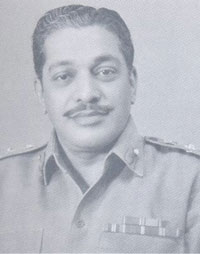
General Deshamanya Don Sepala Attygalle, was a Sri Lankan senior army officer, civil servant and diplomat. The longest serving Commander of the Sri Lankan Army (1967–1977), he went on to serve as the Permanent secretary to the Ministry of Defence and Sri Lankan High Commissioner to the United Kingdom.
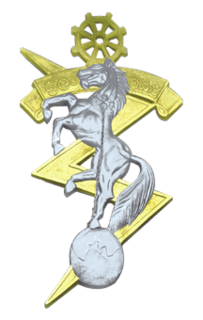
The Sri Lanka Electrical and Mechanical Engineers (SLEME) is a Combat Support corps of the Sri Lanka Army. It is made up of six regular regiments and one volunteer (reserve) regiment. Regiment Center located at Kew Road, Slave Island, Colombo. The present strength of the corps is 200 officers and 5763 other ranks.

The Sri Lanka Army Medical Corps (SLMC) is a specialist corps in the Sri Lanka Army which specializes in military medicine and provides medical services to all army personnel and their families in war and in peace. It is made up of 4 regular units and one volunteer unit. Headquartered in Colombo, formally at army headquarters. The corps Cap badge depicting the Rod of Asclepius. General officers and senior officers of the SLMC wear gorget patches of maroon rather than of scarlet worn by other officers of similar rank.
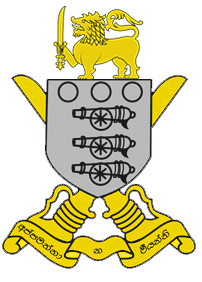
The Sri Lanka Army Ordnance Corps (SLAOC) is a combat support corps of the Sri Lanka Army. The role of the corps is the procurement, receipt, storage, accounting, maintenance, control, issue and disposal of ordnance stores. It is made up of seven regular ordnance battalions, three Base Depots, one volunteer (reserve) ordnance battalion, and many independent ordnance depots. It is headquartered at the Regimental Centre, Dombagoda.

The Sri Lanka Army Service Corps (SLASC) is a Combat Support corps of the Sri Lanka Army. The role of the corps is to carry supplies to the soldier where he is, and run an efficient organization for the provision of transport, fuel, oil and lubricants which are the 'life blood of an army’. It is made up of 7 regular units and one volunteer (reserve) units and is headquartered at its Regiment Center at the Panagoda Cantonment, Panagoda. The corps has a trade school in Anuradhapura which trains drivers, cooks and clerks for the Army.

The Corps of Engineer Services (CES) a regiment of the Sri Lanka Army. The role of the Corps of Engineer Services is to design, construct and maintain all buildings, roads and associated facilities such as electricity, water supply and drainage systems used by the Sri Lanka Army, Apart from this, the Regiment is also responsible for the installation, maintenance and repair of all types of generators, water pumps, sewer pumps, desalination plants and other electrical appliances. It is made up of 6 regular units and 9 volunteer (reserve) units and is headquartered at its Regiment Center at the Panagoda Cantonment, Panagoda.

General Deshamanya Joseph Everard Denis Perera, VSV, FCMI was a senior Sri Lanka Army officer who served as Commander of the Sri Lankan Army from 1977 to 1981. He was also the Sri Lankan High Commissioner to Australia, Chairman of the Securities and Exchange Commission and the Ceylon Tobacco Company and Chancellor of General Sir John Kotelawala Defence University. He envisioned for a women's corps in the army which resulted in the creation of the Sri Lanka Army Women's Corps in 1979.
The 1962 Ceylonese coup d'état attempt was a failed military coup d'état planned in Ceylon. A group of Christian officers in the military and police planned to topple the government of Prime Minister Sirimavo Bandaranaike during the night of 27 January 1962. Organised by Colonel F. C. de Saram, Colonel Maurice De Mel,, Rear Admiral Royce de Mel, C.C. Dissanayake, Sydney de Zoysa and Douglas Liyanage, it was to take place in the night of 27 January 1962, but was called off as the government gained information in the afternoon and initiated arrests of the suspected coup leaders before the coup was carried out.
General Shavendra Silva, WWV, RWP, RSP, VSV, USP is a Sri Lanka Army officer. He is the Chief of Defence Staff and former Commander of the Sri Lanka Army, His prior appointments include, Chief of Staff of the army, Adjutant General and Director of Operations of the Army. During the Sri Lankan civil war he gained fame as the General Officer Commanding of the elite 58 Division. He had also served as the Deputy Permanent Representative to the United Nations Headquarters.

Sri Lankan military bands refer to the joint-service musical units of the Sri Lanka Armed Forces representing the Sri Lanka Army, the Sri Lanka Navy, and the Sri Lanka Air Force. The three bands mentioned, which were established in 1949, 1952 and 1970 respectively and are the seniormost in the armed forces. They are composed of many ceremonial marching bands as well as concert bands which are base for the band's success. The band participates in main social and cultural events, including formal state visits and military parades. All army regiments also contain a regimental band for ceremonial duties.















